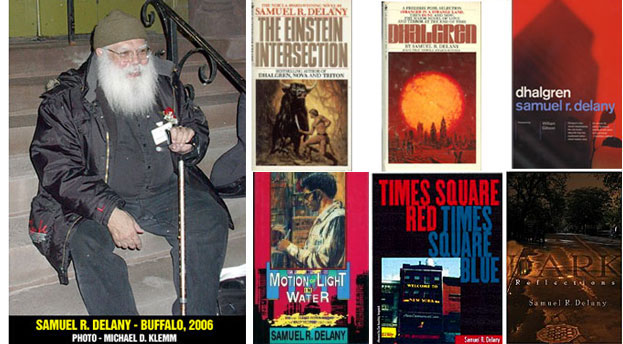
 |
||||||
|
GAY
FILM REVIEWS BY MICHAEL D. KLEMM
|
||||||
|
The
Polymath, Maestro
Media, Director:
Starring:
Unrated, 75 minutes |
Sexuality
& Science Fiction 101
"I
think of myself as the world's most ordinary, dull, black faggot." The Polymath, or The Life and Opinions of Samuel R. Delany, Gentleman (try saying that three times fast) is a fascinating documentary, directed by Fred Barney Taylor, about one of today's greatest living authors. |
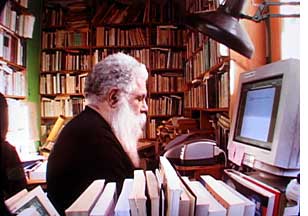 If
ever there was a case to be made that somebody's sexual identity is an integral
part of that person's art, look no further than "Chip" Delany. When famed
writer E.M. Forster's homosexuality became known
with certainty, following the posthumous publication of Maurice
in 1971, many longtime Forster scholars refused to accept that the author
was gay or that his sexuality influenced or shaped his books in any way.
And this is just silly. In Delany's case, his sexuality is so entwined in
his writings that a difference can be barely be drawn between the two. His
science fiction probably features the most frank and adult treatments of
sex (in all its manifestations) to ever appear in the genre. If
ever there was a case to be made that somebody's sexual identity is an integral
part of that person's art, look no further than "Chip" Delany. When famed
writer E.M. Forster's homosexuality became known
with certainty, following the posthumous publication of Maurice
in 1971, many longtime Forster scholars refused to accept that the author
was gay or that his sexuality influenced or shaped his books in any way.
And this is just silly. In Delany's case, his sexuality is so entwined in
his writings that a difference can be barely be drawn between the two. His
science fiction probably features the most frank and adult treatments of
sex (in all its manifestations) to ever appear in the genre. |
|
|
|
|
| Delany is a unique phenomenon in modern literature. Taylor's documentary takes a very unconventional approach to examine its very unconventional subject, mixing interview footage and old home movies with abstract imagery to compose an evocative and challenging portrait of the artist. | |
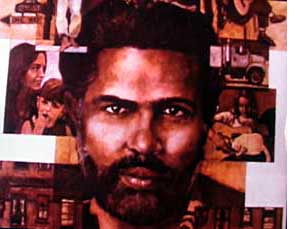 Much
of the film feels as if you are having a conversation with a close friend.
What will interest queer audiences, who are unaware of the man's work, is
the frankness in which the writer discusses his legendary sex life. Once
married to poet Marilyn Hacker (who knew that he identified as gay), neither
partner believed in monogamy. During the film's first minutes, Delany has
already opened up about being 19, living in New York's lower east side,
and indulging in anonymous sex with multiple partners during the day while
still having dinner ready for his wife when she came home from work. The
accompanying images during this prologue consist of street scenes, trains,
bridges and urinals. Finally, the camera pans down a striking black & white
photograph of a shirtless young black man, with a guitar, looking like Harry
Belafonte. Those unfamiliar with Delany will probably be startled by his
first appearance a few moments later. Sporting the trademark long white
beard that he has worn since the 1970s, he barely resembles the sexual rancanteur
we just heard speaking; he looks more like Santa Claus. Much
of the film feels as if you are having a conversation with a close friend.
What will interest queer audiences, who are unaware of the man's work, is
the frankness in which the writer discusses his legendary sex life. Once
married to poet Marilyn Hacker (who knew that he identified as gay), neither
partner believed in monogamy. During the film's first minutes, Delany has
already opened up about being 19, living in New York's lower east side,
and indulging in anonymous sex with multiple partners during the day while
still having dinner ready for his wife when she came home from work. The
accompanying images during this prologue consist of street scenes, trains,
bridges and urinals. Finally, the camera pans down a striking black & white
photograph of a shirtless young black man, with a guitar, looking like Harry
Belafonte. Those unfamiliar with Delany will probably be startled by his
first appearance a few moments later. Sporting the trademark long white
beard that he has worn since the 1970s, he barely resembles the sexual rancanteur
we just heard speaking; he looks more like Santa Claus. |
|
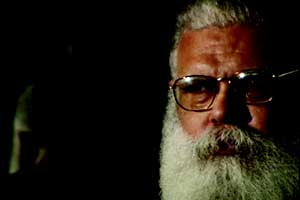 His
unapologetic candor is disarming, but at the same time he has this folksy
Burl Ives quality in which he manages to make anecdotes about having sex
in the back of trucks with a half a dozen men sound nostalgic. Delany freely
confesses that he has enjoyed thousands of sex partners during his life.
He seems, at times, like he would be the CDC's worst nightmare, but he does
address his rather cavalier attitude towards sex. Considering his history,
it is a minor miracle that he never contracted AIDS, but he explains that
he rarely engaged in sexual behavior that involved penetration. "I would
not or could not advise anyone to follow my lead or example," he admits.
Whatever one thinks about his behavior - which is decidely outside
of the norm - you have to admire the man's honesty... His
unapologetic candor is disarming, but at the same time he has this folksy
Burl Ives quality in which he manages to make anecdotes about having sex
in the back of trucks with a half a dozen men sound nostalgic. Delany freely
confesses that he has enjoyed thousands of sex partners during his life.
He seems, at times, like he would be the CDC's worst nightmare, but he does
address his rather cavalier attitude towards sex. Considering his history,
it is a minor miracle that he never contracted AIDS, but he explains that
he rarely engaged in sexual behavior that involved penetration. "I would
not or could not advise anyone to follow my lead or example," he admits.
Whatever one thinks about his behavior - which is decidely outside
of the norm - you have to admire the man's honesty... |
|
|
|
 The
Polymath
isn't about just his sex life, but a good chunk of it is and it all
relates to his writings. Take for example an early scene in which he is
reading, to an audience, the opening paragraphs of his 1966 short story,
"Aye and Gomorrah" (which first appeared in fellow science fiction author
Harlan Ellison's groundbreaking anthology, Dangerous Visions). The
story begins in France in a pissoir and Delany describes this as "an early
attempt to deal, in a highly coded fashion, with homosexuality." That it
involves a public restroom invokes the obvious autobiographical element. The
Polymath
isn't about just his sex life, but a good chunk of it is and it all
relates to his writings. Take for example an early scene in which he is
reading, to an audience, the opening paragraphs of his 1966 short story,
"Aye and Gomorrah" (which first appeared in fellow science fiction author
Harlan Ellison's groundbreaking anthology, Dangerous Visions). The
story begins in France in a pissoir and Delany describes this as "an early
attempt to deal, in a highly coded fashion, with homosexuality." That it
involves a public restroom invokes the obvious autobiographical element.
|
|
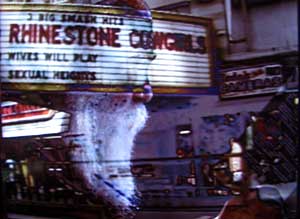 This
is also true for Times Square Red Times Square Blue. In this nonfiction
opus, Delany argues that "cleaning up" Times Square and turning it into
Disneyland is not a good thing because, once upon a time, people from different
races and classes, normally kept separate, met and interacted in the only
social situation available to them and that was the porn theaters. Delany
is one of the few writers alive who can explicitly describe the public sex,
involving himself and others, that went on in these venues and work it into
an essay about the infrastructure of cities. This
is also true for Times Square Red Times Square Blue. In this nonfiction
opus, Delany argues that "cleaning up" Times Square and turning it into
Disneyland is not a good thing because, once upon a time, people from different
races and classes, normally kept separate, met and interacted in the only
social situation available to them and that was the porn theaters. Delany
is one of the few writers alive who can explicitly describe the public sex,
involving himself and others, that went on in these venues and work it into
an essay about the infrastructure of cities. |
|
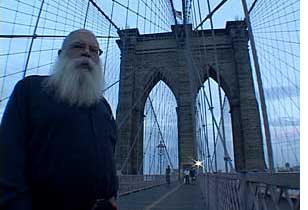 But
all of his metaphors aren't carnal. The ruined and mostly abandoned city
in Dhalgren (a book that is the science fiction equivalent of James
Joyce's Ulysses) was inspired by the real burned out inner cities
he knew from life. He explains that the reasons for making the gender of
certain characters ambiguous in Stars In My Pocket Like Grains Of Sand
(1984) was because he once lived in a hotel with several transsexuals and
it drove him crazy, at first, when he couldn't discern the sex of some of
the people in the elevator with him. But
all of his metaphors aren't carnal. The ruined and mostly abandoned city
in Dhalgren (a book that is the science fiction equivalent of James
Joyce's Ulysses) was inspired by the real burned out inner cities
he knew from life. He explains that the reasons for making the gender of
certain characters ambiguous in Stars In My Pocket Like Grains Of Sand
(1984) was because he once lived in a hotel with several transsexuals and
it drove him crazy, at first, when he couldn't discern the sex of some of
the people in the elevator with him. |
|
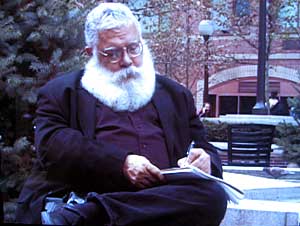 Besides
his writings, Delany also discusses his life and his family's history. His
grandfather was a freed slave, a cousin was killed by the Klan, his two
famous aunts (who both lived to be over 100) organized a picket line at
a movie theater showing Birth Of A Nation in 1924. Chip has much
to say on the subject of racism, comparing the attitudes of white students
towards Paul Robeson at Columbia Law School to the skinheads who dragged
James Bird Jr. to his death as he was chained to the back of their truck. Besides
his writings, Delany also discusses his life and his family's history. His
grandfather was a freed slave, a cousin was killed by the Klan, his two
famous aunts (who both lived to be over 100) organized a picket line at
a movie theater showing Birth Of A Nation in 1924. Chip has much
to say on the subject of racism, comparing the attitudes of white students
towards Paul Robeson at Columbia Law School to the skinheads who dragged
James Bird Jr. to his death as he was chained to the back of their truck. |
|
 Footage
of the author speaking, in various locales, permeate The
Polymath. We see him surrounded by the books in his study,
sitting in a subway station, visiting an artist's installation based on
Dhalgren, and talking to drag queens and a man in leather at a Gay
Pride parade. One playful sequence shows Delany walking through an exhibit
of modern art and ends as he ponders a small urinal laying on its side on
a pedestal. But this is a very experimental documentary; at times the author's
ruminations are accompanied by abstract and often layered imagery. These
are suggested by Delany's words. Bridges, ruined buildings and trains predominate.
Light shining on rippling water (suggested by the title of his 1988 memoir)
is superimposed over the tops of moving subway trains. A shot of the Brooklyn
Bridge, almost hidden in fog, evokes an opening scene from Dhalgren.
The structure is non-linear, like many of the author's novels, and this
approach seems oddly appropriate and effective. Footage
of the author speaking, in various locales, permeate The
Polymath. We see him surrounded by the books in his study,
sitting in a subway station, visiting an artist's installation based on
Dhalgren, and talking to drag queens and a man in leather at a Gay
Pride parade. One playful sequence shows Delany walking through an exhibit
of modern art and ends as he ponders a small urinal laying on its side on
a pedestal. But this is a very experimental documentary; at times the author's
ruminations are accompanied by abstract and often layered imagery. These
are suggested by Delany's words. Bridges, ruined buildings and trains predominate.
Light shining on rippling water (suggested by the title of his 1988 memoir)
is superimposed over the tops of moving subway trains. A shot of the Brooklyn
Bridge, almost hidden in fog, evokes an opening scene from Dhalgren.
The structure is non-linear, like many of the author's novels, and this
approach seems oddly appropriate and effective. |
|
 I
freely admit that I have been a fan of Delany's books for over thirty years.
I even met the man when he spoke here in Buffalo. I've always been intrigued
by the mysterious qualities in his works and so I was enthralled by The
Polymath. But I came to the film already armed with an arsenal
of prior knowledge and I am unsure how it will play to the uninitiated.
A documentary shouldn't need Cliff Notes (although this is hardly a conventional
documentary and shouldn't be taken as such) and many things are left unexplained.
There are curious omissions; Delany refers to his wife but she is never
identified (even though she is a famous poet). Clips from an avante-garde
film by Delany, named The Orchid, are shown but never elaborated
upon. I suspect that some of this will be confusing, if not maddening, to
the novice. I
freely admit that I have been a fan of Delany's books for over thirty years.
I even met the man when he spoke here in Buffalo. I've always been intrigued
by the mysterious qualities in his works and so I was enthralled by The
Polymath. But I came to the film already armed with an arsenal
of prior knowledge and I am unsure how it will play to the uninitiated.
A documentary shouldn't need Cliff Notes (although this is hardly a conventional
documentary and shouldn't be taken as such) and many things are left unexplained.
There are curious omissions; Delany refers to his wife but she is never
identified (even though she is a famous poet). Clips from an avante-garde
film by Delany, named The Orchid, are shown but never elaborated
upon. I suspect that some of this will be confusing, if not maddening, to
the novice. |
|
|
|
|
| UPDATE
FOR THE DVD When I wrote the preceding review, The Polymath was not yet available on DVD, The film can now be purchased and comes with a bonus disc that includes over two hours of un-used interview footage. |
|
 Watching
the raw deleted footage gives the viewer a sense of the Herculean editing
task faced by the filmmaker. Much of what fell to the cutting room is as
interesting as what was enshrined in the finished film. Some of it elaborates
on material covered in The Polymath
but much of it is completely new. The bonus disc features Delany's further
ruminations on: 1. Personal History, 2. Sex, 3. Books, 4. Race, 5. Gay History,
6. How I Write. It concludes with Delany's 36 minute film, The Orchid,
in its entirety. Watching
the raw deleted footage gives the viewer a sense of the Herculean editing
task faced by the filmmaker. Much of what fell to the cutting room is as
interesting as what was enshrined in the finished film. Some of it elaborates
on material covered in The Polymath
but much of it is completely new. The bonus disc features Delany's further
ruminations on: 1. Personal History, 2. Sex, 3. Books, 4. Race, 5. Gay History,
6. How I Write. It concludes with Delany's 36 minute film, The Orchid,
in its entirety. |
|
 The
new material is too much to absorb in one sitting. Taken in pieces, to fill
the large jigsaw puzzle, the viewer is provided with an even more complete
portrait of the artist. It is not uncommon, while assembling a documentary
or non-fiction film, for hours of interview footage to be discarded. A special
edition DVD like this one, therefore, is the ideal format when an audience
hungers for more information and much of this is riveting. Delany discusses
the effect of Dyslexia on his writing; his marriage to Marilyn Hacker, growing
up in Harlem, his beard, his stay in a mental hospital. He explains the
etiquette of public sex. On race matters, he recounts the voyage of slaves
aboard the Armistead and the history that African Americans grew out of.
Gay history is highlighted by his personal anecdotes about Stonewall. Delany
cites Susan Sontag's 1964 Notes On Camp and offers an elaborate dissertation
on gay slang and camp, complete with the linguistic and historical origins
of the words coming out, camp and drag. The insights into
his writing habits are particularly fascinating. The
new material is too much to absorb in one sitting. Taken in pieces, to fill
the large jigsaw puzzle, the viewer is provided with an even more complete
portrait of the artist. It is not uncommon, while assembling a documentary
or non-fiction film, for hours of interview footage to be discarded. A special
edition DVD like this one, therefore, is the ideal format when an audience
hungers for more information and much of this is riveting. Delany discusses
the effect of Dyslexia on his writing; his marriage to Marilyn Hacker, growing
up in Harlem, his beard, his stay in a mental hospital. He explains the
etiquette of public sex. On race matters, he recounts the voyage of slaves
aboard the Armistead and the history that African Americans grew out of.
Gay history is highlighted by his personal anecdotes about Stonewall. Delany
cites Susan Sontag's 1964 Notes On Camp and offers an elaborate dissertation
on gay slang and camp, complete with the linguistic and historical origins
of the words coming out, camp and drag. The insights into
his writing habits are particularly fascinating. |
|
|
In closing, The Polymath, and all of its bonus supplements, does an admirable job introducing the casual viewer to one of our greatest, and most unique, living authors. Longtime admirers of Delany will find a smorgasbord here. A trailer can be viewed at www.maestromedia.net. For inquiries, and ordering information, please e-mail: maestromedia@nyc.rr.com.
|
|
| Samuel
R. Delany also appears briefly in: Wrangler: Anatomy of an Icon |
